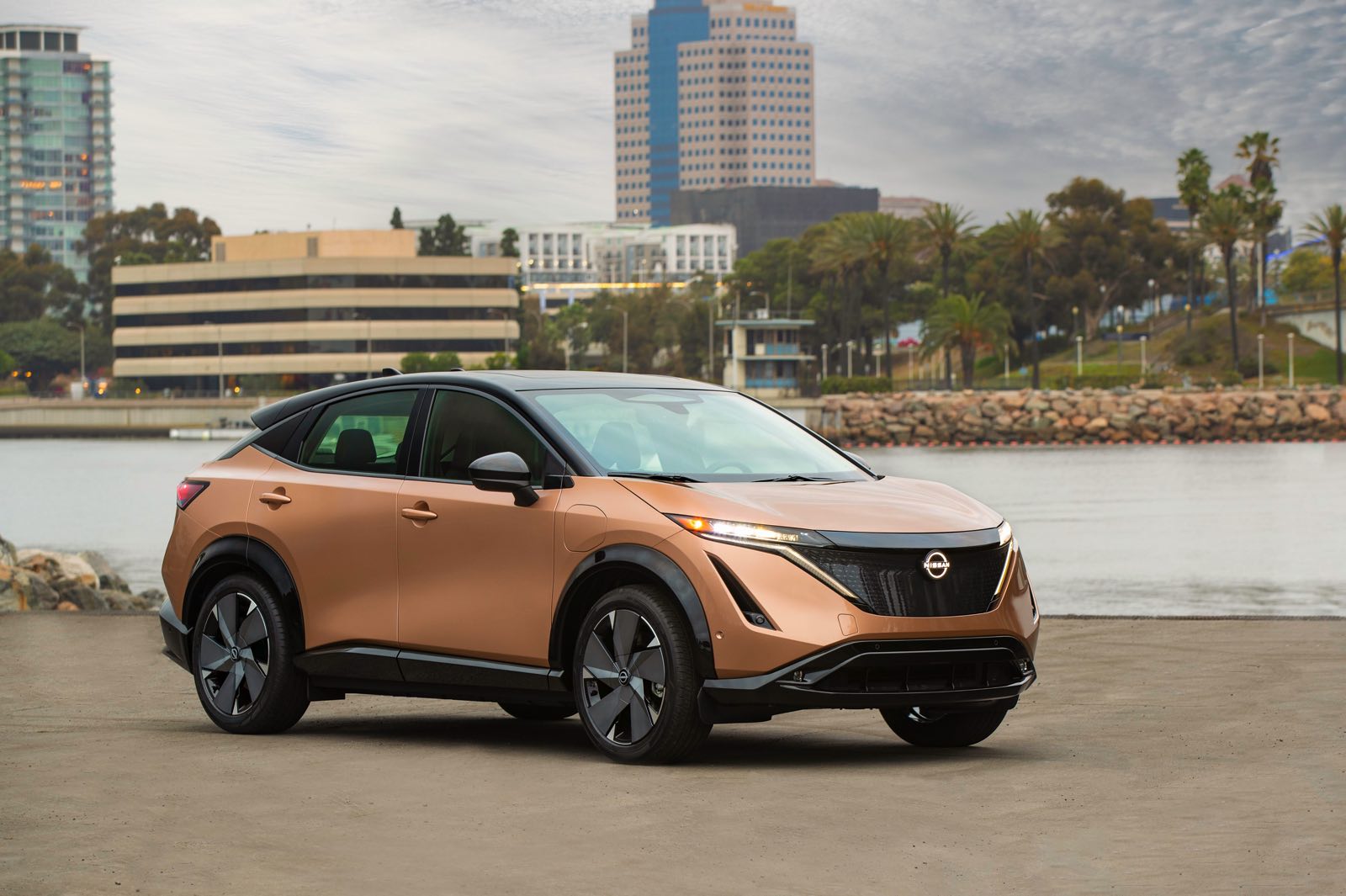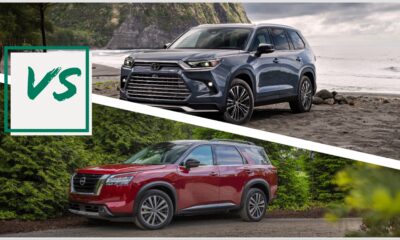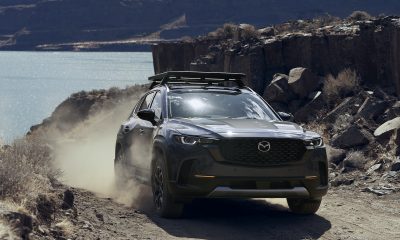Car Reviews
NISSAN’S ARIYA – Turning Over A New Leaf
NISSAN’S ARIYA
Turning Over A New Leaf
HOPE, Ark. – Ten miles from Hope, the Nissan Ariya began having the automotive equivalent of a nervous breakdown.
Let’s stipulate that the offspring of the Nissan Leaf is spacious, quiet, comfortable, powerful, and sophisticated. It is also expensive and a nuisance to keep charged on road trips across flyover America, the very reasons that the electrification of America’s vehicle fleet is not as close as it may appear.
All I wanted to do was get the thing charged enough so that when the nice man came out from Dallas to return the Ariya he could drive toward Dallas, not Little Rock. When I left the house, the car said it had 43 miles of range, and the GPS said the Level 3 charger I sought was 31 miles away.
That seemed reasonable, but the car soon began to issue a series of dire warnings that we might not reach the Electrify America charging station near the U.S. 278 exchange on I-30. So many in fact that I developed Plan B, which entailed calling a tow truck and sending the bill to Nissan.
By my calculations, I was in good shape. The difference between the range and the distance to the charger grew somewhat after I eased the car into the slow lane and blended into the never-ending line of 18-wheelers.
Still, every couple of miles it flashed a scary warning that it might run out of power and shut down at any moment. I began to wonder if empty came before empty, if the car needed a minimal amount of power to run the operating system. Was this just a digital nanny, or was automotive Armageddon dangling by a thread over my weathered brow?
Gorgeous cabin
Pardon the Baby Boomerism, but this was a real bummer. Before all this started, the car was an absolute joy to drive, especially at night. With a flat floor and the climate control system under the hood instead of in the dash, Ariya’s cabin is as roomy as any lounge dance floor.
Premium materials and innovative design techniques are deployed throughout. A wraparound LED light strip and backlit geometric patterns inspired by Japanese Kumiko woodworking blend into two large screens across the dash, which themselves are underscored by flush touch capacitive climate control switches embedded in a matte wood trim.
Add in a head-up display featuring Nissan’s ProPILOTtm Assist, which detects vehicles ahead and abreast and practically drives itself, plus a kicking sound system made all the better by a whisper-quiet ambiance and what’s not to like?
The thought of being stranded on a dark night alongside the Red River, for one.
Pricey
The Nissan Ariya starts at $43,190 and comes in four basic configurations. The base includes a 63-kWh battery pack with a single electric motor and front-wheel drive with 214 hp or two electric motors and an all-wheel drive with 335 hp. Our tester was an Empower+ with an 87-kWh battery and front-wheel drive with 238 hp. With options and delivery fee, it listed for $59,395.
Unlike the Leaf, which is built in Tennessee, the Ariya is built solely in Japan and, thus, is not eligible for up to $7,500 in federal income tax credits.
Maybe it’s just me, but I think a $60,000 Nissan is a tough sell. It is, however, congruent with EV prices. According to Kelly Blue Book, the average price of an electric vehicle is around $66,000, or about $18,000 more than an average gas-powered vehicle.
There is a wide range of prices, to be sure, and some indication that EV prices are beginning to come down. A series of price cuts from Tesla is forcing legacy manufacturers to keep up. Ford, for example, has cut prices of the Mustang Mach-E by $5,900. They now sell from between $43,000 to $60,000.
We recently had our hands on Toyota’s new electric SUV, the bZ4X. The range and driving dynamics were similar to the Ariya’s but the top-of-line price was $48,780. And it feels like a Toyota – solid.
On the other hand, General Motors last week said it was converting the factory it uses to build the sub-$30,000 Chevrolet Bolt into a site for the electric Silverado because, after all, what the country needs right now is another $100,000 pickup.
Nissan says it plans 15 more electric vehicles. For the sake of the planet, let’s hope some of them fit middle-class budgets.
Charging time
I was about two miles from the Hope charging station when the gauge cluster went orange and the car told me the end was near.
There was nothing to do besides drive on, stay in the right lane in case I had to suddenly pull off that crowded dark highway, and hope – see what I did there? – for the best.
Fortunately, a couple of recent encounters with electric vehicles have made me adroit at bypassing a crowded parking lot at this site. That I have been forced to learn this is a salient commentary on the irrational rationale on display on the state of the charging network in fly-over America.
Of the nearly 60,000 charging stations open in America, more than a fourth are in California and nearly all are concentrated around major population centers on the coasts.
Though I live in a standard metro area with some 135,000 residents that sits at the confluence of two major highway arteries and has more than a dozen interstate interchanges, it is home to not one – that’s zero – Level 3 charging station.
OK, there are two that service Teslas, but a lack of hardware standardization means those only work with Elon-mobiles. EVs from Ford, BMW, Audi, VW, Cadillac, Chevrolet, Nissan, Polestar, Goldilocks, and The Three Bears are out of luck.
To be sure, there are Level 2 chargers available in my town, but using one of those is an all-night affair. Indeed, according to Nissan USA, the base Ariya Engage trim with the smaller battery pack can recharge in roughly 10 hours using a Level 2 charger. An Empower model, like our tester, with a larger battery, can take up to 14 hours.
Obviously, if I owned an EV I would not hesitate to call a competent electrician and spend $500 to $1,000 to install a dedicated 30-amp service and use the 220-amp charger in the Ariya’s trunk. The EPA estimates that using home charging will cost about $700 a year to go 15,000 miles, substantially less than gasoline for a typical vehicle.
I don’t have a home charger. Instead, I must travel 30 miles east to a town of 8,800 people with two Interstate exchanges or 60 miles west to Mount Pleasant, a town of 16,000 people, to power up. That station, by the way, is on the opposite side of town from the Interstate.
In the seven days the Nissan Ariya spent in our driveway, it hit the Mount Pleasant site thrice. When the nice man brought the car out from Dallas, he topped off there. Though Nissan and the EPA say the larger-battery version can get about 289 miles on a charge, that was not calculated on Texas interstates. When the car arrived at my house, it had about 173 miles left on it. That plus 60 doesn’t equal 289.
A few days later, it was down to 120 miles, and I was looking to cover a sporting event some 80 miles away, so Blonde Bride and I headed out to Hope for shopping, a great meal at El Agaves, and electricity. I earlier learned that if charging an EV to 80% costs x, pushing it to 100% costs 2x. Don’t ask me why. It was about 90% full, and showing a range of 220 miles, when I unplugged, having spent nearly $20. We took a secondary road home to conserve energy.
The next day, having expended 30 precious miles to get home, I set out on my assignment. I soon realized I could get there, but I wouldn’t be able to get home, so on the way I stopped in Mount Pleasant and bought another $8 worth of electricity.
On my way home, I realized I had enough to get home, but not enough to return the next day for Part II of the assignment. So I veered off into Mount Pleasant again. This was in a driving rainstorm. Here’s a revelation: Most charging stations are not covered.
I had to find a dry spot on my T-shirt so I could interact with the touch screen, but after several tries, I finally got the darn thing to link up with the car and accept my debit card. I sauntered off into a nearby cut-rate grocery store – the only thing there – to kill about 20 minutes. When I returned, I discovered the charger had cut off after one minute.
It had only charged me $0.87, but when I got home, the Ariya had less than 60 miles of range remaining. I parked it and used our Camry to complete my assignment. I was going to leave it like that, but I realized the nice man would never make it to Mount Pleasant. He could either park his tail in front of a Level 2 charger in town all day, or go to Hope, charge up, and backtrack.
Thus began my journey to Hope.
I did make it, but the first two chargers I attempted to use would not work. That prompted some anxiety. The third did, but it was not as powerful as the other two, so my visit was made longer. After an hour or so, and $25 later, I had enough juice to get home and for the nice man to make it to Mount Pleasant with 50 miles to spare.
If you’re doing the math, that means I spent more than $50 to cover about 250 miles. That’s as bad as driving a gas-guzzling SUV that only gets 15 mpg.
Bottom line:
Make no mistake, electric vehicles are coming. Manufacturers have committed hundreds of billions of dollars to building new auto and battery factories and some are near completion. This year, nearly one in five new cars sold will be electric, and next year that will be nearly one in four, according to the Society of Motor Manufacturers and Traders.
By 2030, according to most estimates, the nation will have nearly 600,000 charging stations. Technological advances like solid-state batteries and wireless charging are nearly ready for deployment.
Today, however, high vehicle prices and travel difficulties place massive boulders in the stream of change.































